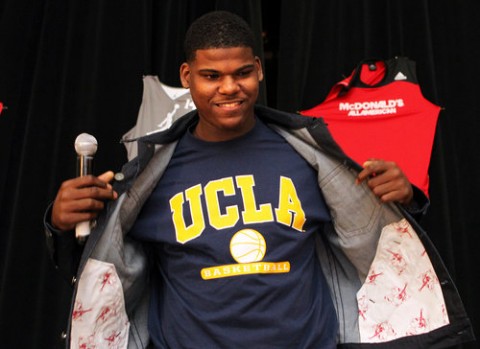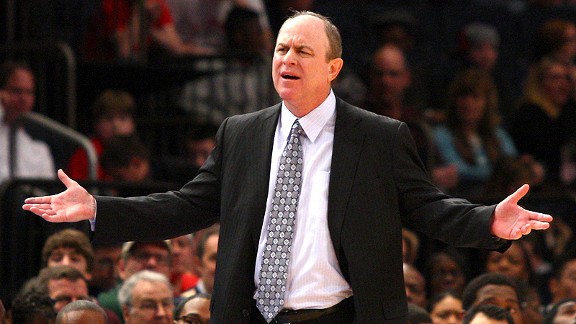Baby Bruins v.2: Comparing UCLA’s Situation Now to Top-Ranked Class of 2008
Posted by EJacoby on April 25th, 2012Evan Jacoby is a regular contributor for RTC. You can find him @evanjacoby on Twitter.
With the news on Monday that top unsigned big man Tony Parker is headed to UCLA next season, the Bruins now have a super-stacked recruiting class for next year that should give Ben Howland’s squad a great chance to become elite right away. Recall that last week we discussed that bringing in an elite recruiting class doesn’t necessarily result in program success, with one of the highlight examples being Ben Howland’s #1 class of 2008 Bruins. That UCLA team brought in the top recruiting class and also had some returning veteran talent, but the team badly failed to meet expectations (some of the roots of UCLA’s transgressions were recently highlighted in a popular Sports Illustrated article in late February). Fair or unfair, the 2012 class and next year’s team is going to have to deal with comparisons to those 2008 Baby Bruins, at least until it starts to win. This time around, though, their coach’s job is on the line too. Let’s take a quick look at how the two classes and situations match up, and why UCLA fans should have no reason to expect a repeat performance this time around.

Now That Tony Parker Signed with UCLA, the Bruins Have Huge Expectations Again (Photo: Atlanta Journal Constitution)
Back in 2008, UCLA was coming off of three straight Final Four appearances, one of the best runs of team success of the past decade for any program. Bringing in the top recruiting class that offseason was no surprise, and that group of freshmen was expected to continue the long tradition of winning in Westwood. Jrue Holiday, Malcolm Lee, and Drew Gordon were part of a group of five top-50 recruits who were quickly dubbed the Baby Bruins, players who “were famous before they played a game,” as the SI report claims. The freshmen also got to play alongside some returning veterans, most notably senior All-American Darren Collison. But UCLA was unable to win with this group right away that season nor during the next four years. Instead of stacking up Ws and bringing home banners like the previous groups led by Jordan Farmar, Arron Afflalo and Kevin Love, the Baby Bruins never made the Sweet Sixteen in four years and failed to make the NCAA Tournament twice. The disastrous chemistry on the team throughout this period led to players fighting and transferring, and it all ended up in far more losses than anyone expected. UCLA entered this offseason really in need of a talent (and attitude) infusion.
Now we’re in 2012 and UCLA again brings in the top (or number two, depending on the rating system you like) recruiting class for the upcoming season, this time under much different circumstances. Instead of looking to continue a streak of Final Four appearances, the new Bruins need to turn around a struggling program. And their coach is definitely on the hot seat at a school that hasn’t traditionally given very long leashes. Fortunately for Howland and the rest of the program, the 2012-13 Bruins are going to be stacked. With Parker’s announcement, UCLA now has four top-40 recruits coming in next season in the form of Shabazz Muhammad (#1 SF, #2 overall according to ESPN.com), Kyle Anderson (#2 SF, #5 overall), Jordan Adams (#9 SF, #40 overall), and Parker (#7 C, #26 overall). Only Kentucky’s incoming class could possibly rival this haul, and the Wildcats are losing their top six players to the NBA next season. UCLA, on the other hand, still has veteran talent left over for next season in the form of Travis Wear, David Wear, Josh Smith (all tall front line players), Tyler Lamb, and Larry Drew (both guards). Mix in the four talented frosh with these improving four holdovers (Drew is an incoming transfer from UNC), and UCLA will have one of the most talented top-to-bottom rosters in the country next season.
So what can we expect from next year’s Bruins? How can this group avoid the perils of the previous top class? The second question is anyone’s guess, as you just never know how different players will mesh with each other both on and off the court. All indications show that the incoming crop of freshmen are hard-working, coachable players, but the same thing is said about nearly all newcomers, and the same coach is around now (Howland) that was in charge of the previous volatile group. But the only reason why we’re even questioning the ability of this group to get along is because of the 2008 Baby Bruins, and that’s probably unfair. The main culprit of distress from the last couple of seasons was Reeves Nelson, and he is long gone from the program. Until there are any signs of turmoil amongst this group, there’s no reason to be anything but incredibly optimistic about its potential.
As for answering the other question (what to expect?), there is a much greater chance that the upcoming Bruins team will be a Final Four-caliber contender than it will resemble the struggling teams of the past four years. Even if the inconsistent Smith remains out of shape and the incoming transfer Drew never quite fits in (he was a mild disaster at North Carolina), UCLA is still stacked with talent. The Wear twins have developed into versatile, reliable forwards that each bring something different to the table (both averaged over 10.2 points and 5.9 rebounds per game last year). David can range out to the perimeter (14-30 from three last season) and is a bit more productive offensively, while Travis is a more physical paint presence (1.2 blocks per game). Lamb is another talented guard who can be a productive wing scorer. But it’s the freshmen that will lead the way, as Muhammad and Anderson both have a chance to be special. Muhammad is a 6’6” perimeter player with elite scoring ability and NBA-level offensive skills. Anderson is even taller at 6’7” but also plays on the perimeter, displaying uncanny vision and playmaking ability for his size. Both will be immediate matchup problems who may take a while to mesh but should eventually become a dynamite one-two UCLA punch. Throw in Parker, a 6’9” wide body with strong offensive skills, and Adams, a prototypical attacking small forward that can shoot, and UCLA has no fundamental on-court weakness.
This time around, UCLA has no excuses. There’s no hangover from past success to which the Baby Bruins may have felt entitled. There’s no lack of comfort that last year’s players may have felt regarding their home court, as legendary Pauley Pavilion will be fully renovated for the upcoming season. And there’s not a single Bruin who is content — the returning players have never tasted success, the freshmen haven’t proven anything, the program higher-ups are embarrassed from the past few seasons, and the head coach is firmly on the hot seat. There will be a lot of pressure on UCLA to start winning right away, but if you look eastward to Lexington, the formula for immediate success is in place. UCLA and its fans should be optimistic as the next generation of Baby Bruins try to erase all memories from the previous four years of disappointment.











































